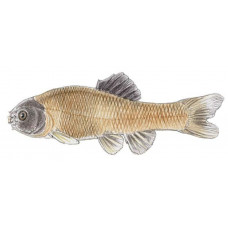Latin name
Pimephales promelas
Other names
Minnow; French: tête de boule.
Identification
The fathead minnow has a puny, deep, compressed body with a short, flattened head. The snout is blunt. The mouth is small and slanted with pharyngeal teeth. The body is usually dull, dark olive or gray on top and pale yellow or white underneath. The scales are larger towards the tail and shallower towards the head, and the lateral line is curved downward and incomplete. There is a dark spot in the center of the anterior dorsal rays, the caudal rays are darkly outlined, and the leading edge of the pectoral fins is black. There is also a strong semi-radial ray on the anterior dorsal fin. There are no spines, but breeding males have tubercles on the snout and the snout becomes darker.
Distribution
This species is widespread (partly due to introduction) throughout North America, from Quebec to the Northwest Territories and south to Alabama, Texas and New Mexico, as well as in Mexico. It is most abundant in the Great Plains and less common in the mountains.
Habitat
Fathead prefer ponds and reservoirs or slow moving water in streams, creeks, and small rivers. They tolerate muddy water and are sometimes found in roadside ditches.
Size
Fathead minnows average 11⁄2 to 3 inches in length and grow to 4 inches. Most die in the third year of life.
Life history and Behavior
For fathead minnows, the spawning season lasts from late spring to summer. It begins when the water temperature exceeds 60°F. They spawn in nests, often under floating or suspended objects, under logs or rocks, usually 1 to 3 feet deep. Males build nests, drive females into them, and guard the nests until the eggs hatch. Several females may lay eggs in one nest, and the clumped eggs hatch in 6-9 days.
Food and feeding habits
The diet of fathead minnows consists mainly of algae, bottom detritus, zooplankton, and insect larvae.
Reproduction
No information
| Classification | |
| Phylum | Chordata |
| Class | Actinopterygii |
| Squad | Cypriniformes |
| Family | Cyprinidae |
| Genus | Pimephales |
| Species | P. promelas |
| Features | |
| Conservation status | Least Concern |
| Habitat | Pelagic |
| Life span, years | 3 |
| Maximum body weight, kg | No information |
| Maximum length, cm | 10 |
| Sailing speed, m/s | No information |
| Threat to people | Edible |
| Way of eating | Predator |


